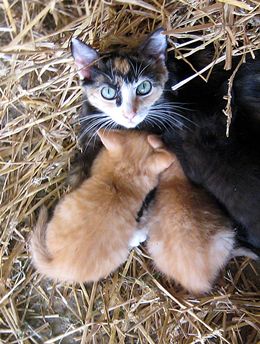|
The Source of Overpopulation
 Stray and feral cats are the greatest source of cat overpopulation. Almost all stray and feral cats are intact (ACA U.S. SN status of cats). Left to their own devices, feral cats are trapped in an endless cycle of breeding and scavenging for food. Stray and feral cats are the greatest source of cat overpopulation. Almost all stray and feral cats are intact (ACA U.S. SN status of cats). Left to their own devices, feral cats are trapped in an endless cycle of breeding and scavenging for food.
This segment of the cat population has been ignored far too long and their numbers have exploded. Stray and feral cats produce 80% of the kittens that flood the shelter each Spring (ACA Feral cat clinic results). These cats and their offspring are the victims of abandonment (see our abandonment flyer) accidental loss or the result of pet owners who allow their intact cats to roam freely and breed unchecked.
Intake Drives Killing
The municipal shelters can't save and support the huge number of accidental litters, stray and family cats brought to the shelter doors everyday. In the U.S. the most comprehensive data indicates that nearly 72% of cats that enter these facilities are killed. For feral cats, the kill rate in shelters and pounds rises to virtually 100% (Cat Fatalities and Secrecy in U.S pound and Shelters). Cats entering the shelter have only three possible outcomes: being adopted, reunited with an owner or killed. Yet feral cats or cats that arrive in a trap to the shelter are unsocialized to humans and can't adjust to life in a human home as they have no traditional "owners" to claim them. For them, the only possible outcome is death.
The solution
The solution is simple. Reduce cat intake in the shelters. Fewer cats means less killing.
Help us, help the cats. By humanely trapping stray and feral cats in your neighborhood you are taking a positive action instead of doing nothing. Your efforts are a step towards ending the cat overpopulation crisis in our city and improving their lives.
Support and utilize non-lethal cat programs like IndyFeral, FACE neighborhood cat package and the Low-cost clinic feral cat package for TNR and low-cost spay neuter services for all cats (U.S Public opinion of the humane treatment of stray cats).
Benefits of TNR and low-cost spay neuter
- To reduce the number of cats and mitigate their suffering from starvation and disease
- Create an economically feasible way for communities to humanely reduce the
population of stray and feral cats, thus easing neighborhood tensions and fostering
compassion
- To relieve local animal control facilities of the financial and emotional burden of
killing healthy cats
The stray and feral cat population must continue to be addressed aggressively in the form of community-wide prevention strategies, increased services, resources, and funding or they will continue to be a significant source of shelter intake.
|